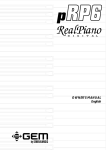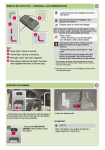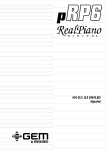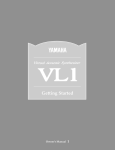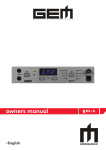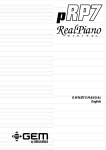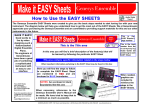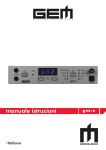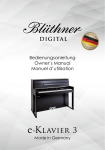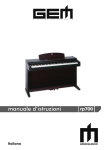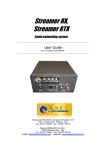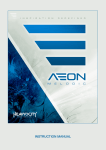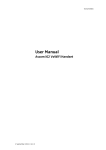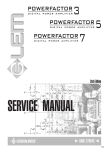Download RPX - Galanti Classic Organs
Transcript
D I G I T A L owners manual •English K E Y B O A R D S rp-x SPECIAL MESSAGES ALARM SYMBOLS: The exclamation mark within an equilateral triangle is intended to alert. Generalmusic electronics products The lightning flash with arrowhead symbol, within an equilateral triangle, is intended to alert the user to the presence of uninsulated “dangerous voltage” within the product’s enclosure that may be of sufficient magnitude to constitute a risk of electric shock to persons. could present labels similar to that displayed in this section. Please follow accurately the precautions descripted in the safety instructions. IMPORTANT NOTE: To reduce the risk related to the correct and normal use of the instrument, all Generalmusic products are accuralety tested in a safety laboratory. DO NOT modify the present unit, the safety standard and the correct instrument operativity could be compromised, and as a further consequence the warranty will be invalidated. This marking shown on the product or its literature, indicates that it should not be disposed with other household wastes at the end of its working life. To prevent possible harm to the enviroment or human health from uncontrolled waste disposal, please separate this from other types of wastes and recycle it responsibly to promote the sustainable reuse of material resources. Household users should contact either the retailer where they purchased this product, or their local government offi ce, for details of where and how they can take this item for environmentally safe recycling. Business users should contact their supplier and check the terms and conditions of the purchase contract. This product should not be mixed with other commercial wastes for disposal. The declaration of conformity can be downloaded from the Generalmusic website:www.generalmusic.com IMPORTANT SAFETY AND INSTALLATION INSTRUCTIONS INSTRUCTION PERTAINING TO A RISK OF FIRE, ELECTRIC SHOCK, OR INJURY TO PERSONS. WARNING! When using electric products, basic precautions should always be followed, including the following: 1. Read all the Safety and Installation instructions and explanations of Graphic Symbols before using the product. 2. This product must be earthed. If it should malfunction or breakdown, grounding provides a path of least resistance for electric current to reduce the risk of electric shock. This product is equipped with a cord having an equipment-grounding conductor and a grounding plug. The plug must be plugged into an appropriate outlet that is properly installed and earthed in accordance with all local codes and ordinances. DANGER:Improper connection of the equipment grounding conductor can result in a risk of electric shock. Check with a qualified electrician or serviceman if you are in doubt as to whether the product is properly grounded. Do not modify the plug provided with the product, if it will not fit the outlet, have a proper outlet installed by a qualified electrician. 3. To reduce the risk of injury, close supervision is necessary when this product is used near children. 4. Do not use this product near water for example, near a bathtub, washbowl, kitchen sink, in a wet basement, or near a swimming pool or the like. 5. This product should only be used by a stand or cart that is recommended by the manufacturer. 6. This product, either alone or in combination with an amplifier and headphones or speakers, may be capable of producing sound levels that could cause permanent hearing loss. Do not operate for a long period of time at a high volume level or at a level that is uncomfortable. If you experience any hearing loss or ringing in the ears, you should consult an audiologist. 7. This product should be located so that its location or position does not interfere with its proper ventilation. 8. This product should be located away from heat sources such as radiators, heat registers, or other products that produce heat. 9. The product should be connected to a power supply only of the type described in the operating instructions or as marked on the product. 10. This product may be equipped with a polarized line plug (one blade wider than the other). This is a safety feature. If you are unable to insert the plug into the outlet, contact an electrician to replace your obsolete outlet. Do not defeat the safety purpose of the plug. 11. The power-supply cord of the product should be unplugged from the outlet when left unused for a long period of time. When unplugging the power supply cord, do not pull on the cord but grasp it by the plug. 12. Care should be taken so that objects do not fall and liquids are not spilled into the enclosure through openings. 13. The product should be serviced by qualified service personnel when: A. The power-supply cord or the plug has been damaged B. Objects have fallen, or liquid has been spilled into the product;or C. The products has been exposed to rain or moisture D. The product does not appear to be operating normally or exhibits a marked change in performance E. The product has been dropped, or the enclosure damaged. 14. Do not attempt to service the product beyond that described in the user-maintenance instructions. All other servicing should be referred to qualified service personnel. 15. WARNING - Do not place objects on product power cord or place it in a position where anyone could trip over, walk on or roll anything over it. Do not allow the product, or its bench, or its pedal board to rest on or to be installed over power cords of any type. Improper installations of this type create the possibility of fire hazard and/or personal injury. 16. Electromagnetic interference (RFI). This electronic product utilizes digital sampled wave processing technology (S.W.P.) that may adversely affect radio/tv reception. Read FCC information inside back cover for additional information. Generalmusic cannot be held responsible for damage caused by improper use or modifications to the instrument, or data lost or destroyed Technical specifications are subject to change The information contained in this manual are considered correct at the moment of printing. Generalmusic reserves the right to change or modify any technical specification without prior notice or obbligation to upgrade existing units. The illustrations and the screens of this manual are for instructional purposes only and may appear different from those on your instrument. SAVE THESE INSTRUCTIONS MANUAL INDEX Introduction Front Panel Rear panel and connections Getting started Power the expander Connect a speaker system Connect a midi master controller Connect pedals Using the input connection Connect The Rp-x To A Pc Connect To A Pc Via Midi Connect To A Pc Via Usb Start the rp-x Listen to the demo sequence The Default Performance Mode Select the performances Manual recalling Midi recalling Edit the performance Selecting the parts (ch) Selecting the parameters to edit in the selected parts (ch): sound Selecting the parameters to edit in the selected parts (ch): volume Selecting the parameters to edit in the selected parts (ch): velocity Selecting the parameters to edit in the selected parts (ch): transpose Selecting the parameters to edit in the selected parts (ch): tune Selecting the parameters to edit in the selected parts (ch): efx Selecting the parameters to edit in the selected parts (ch): rev The mode "ALL" in edit menu Memorize the performance Store the edit in the same performance location Store the edit in a different performance location Exit the performance store Copy the performance Memory management system Common channel setting Midi identification number System reset Midi data bulk (dump) Sound list Performance list Technology Technical specifications Midi implementation chart 1 1 1 2 2 2 3 3 3 4 4 4 5 5 5 6 6 6 7 7 8 8 9 9 9 9 10 10 11 11 11 12 12 13 13 13 14 15 16 17 18 19 19 rp-x Product Package • rp-x expander • Owners manual • Gem PC - Software Editor • AC Adapter • MIDI Cable rp-x owners manual INTRODUCTION Congratulations & thank you for purchasing the GEM rp-x Expander. Utilizing our proprietary DRAKE technology, the rp-x produces a vast variety of acoustic and electric piano sounds with exceptional quality. The rp-x also incorporates an intuitive, yet easy to use operational interface that will satisfy even the most demanding live or professional studio applications. FRONT PANEL 4 2 5 6 3 1 8 rp -x 7 phones 1 This button enter the edit mode and select the editing parameters. These jack connectors allows to plug two headphones to the module. perf 2 midi the Volume knob, set the output level of the instrument. data entry/demo 7 These buttons allows to modify the parameters value. The two buttond pressed at the same time start the demo sequence. This led monitoring the midi data received to the midi input of the module. display 4 volume 6 The perf button (PERFORMANCE), select the performance mode. See the relative chapter, in this manual. 3 edit 5 on/off 8 This button switch on or off the instrument. The 3 digit display visualize the values and the parameters of the various editing levels. REAR PANEL AND CONNECTIONS 3 4 -)$) 0%$!,3 2 $# 53" 5 6 ).054 /54054 1 ). 1 4(25 /54 12 D.C. in 4 USB 5 USB connection to the PC. Use this connection with a proper USB cable to connect the module to a PC. See the relative chapter in this manual. 3 MIDI IN-THRU-OUT The three standard MIDI ports allows the connection of the instrument to a MIDI controller, such as a Master keyboard a Midi Accordion or a PC (equipped with MIDI interface). 2 , 2- , PEDALS it's possible to connect two type of pedals to the expander, an Expression pedal to the Input #2 and a Gem Multipedal unit to the Input #1. Adapter input, in order to avoid hardware problem with this unit, please use the adapter included in the module package only. 2 INPUT The INPUT RCA connectors allows to plug an external (Line) source to the instrument. Consult the relative chapter of this user manual. 6 OUTPUT Connect the instrument to an external speaker system or a Mixer. Page 1 rp-x owners manual GETTING STARTED The Gem rp-x expander is a top quality piano sound generator, designed to be used in the following ways : 1 Played via MIDI from a MIDI master controllers such as a digital piano, a master keyboard, a MIDI guitar, a MIDI accordion. 2 Connected to desktop or laptop PC via MIDI or USB in a MIDI network In this chapter we will cover all the basic steps necessary to properly connect and use the instrument. POWER THE EXPANDER 1 Connect the adapter to a proper voltage A.C. wall plug. $# 0%$!,3 -)$) 53" ). 4(25 /54 /54054 ).054 2 , 2- , CONNECT A SPEAKER SYSTEM 2 Connect audio output of the expander to your live or studio speaker system. $# ). Start the rp-x 4(25 ).054 0%$!,3 -)$) 53" /54 2 /54054 , 2- , Set the global volume NOTE: always turn on the speaker of your system after all the others devices. The rp-x expander is a professional suond generator with a top quality pcm physical/modelling sound library. Always use an adequate stereo external speaker system in order to get the maximum performance from this instrument. Page 2 rp-x owners manual CONNECT A MIDI MASTER CONTROLLER The rp-x module can be used as a powerful piano sound expansion for any type of MIDI controller, digital piano, master keyboard, MIDI guitar and accordion. MIDI OUT MIDI MASTER KEYBOARD $# 0%$!,3 -)$) 53" ). 4(25 /54 /54054 ).054 2 , 2- , MIDI IN MIDI OUT $# 0%$!,3 -)$) 53" ). MIDI Accordion 4(25 /54 /54054 ).054 2 , 2- , MIDI IN MIDI OUT $# 0%$!,3 -)$) 53" ). 4(25 /54 /54054 ).054 2 , 2- , MIDI IN In order to achieve the maximum control of the rp-x, please refer to this next chapter where the different parts of the instrument will be fully explained. CONNECT PEDALS Independently of the MIDI or USB controller you're using with the rp-x, it's possible to connect directly to the module various type of pedals: single switch, multi switch, continuos control. $# The EXPRESSION pedal can be connected to the Pedal Input #2 only 0%$!,3 -)$) 53" ). 4(25 /54 EXPRESSION pedal /54054 ).054 2 SUSTAIN pedal 2- , , SUSTAIN pedal PIANO TYPE prod. code #970116 MULTIPEDAL prod. code #970134 code #970013 prod. code #970464 It is not possible to change these parameters set from the rp-x internal edit menu. However using the advanced PC editor supplied with the module, it’s possible to edit some of these parameters in a very detailed way. USING THE INPUT CONNECTION The rp-x is equipped with RCA stereo input connections. These jacks allow you to connect another instrument (or external LINE audio source) and mix the signal into the audio OUTPUT of the module. Please note that the external mixed signal will be not processed in any way from the rp-x, this is a dry input only. AUDIO OUT $# ). 4(25 ).054 0%$!,3 -)$) 53" /54 2 /54054 2- , , SPEAKER SYSTEM MIDI OUT MIDI IN This connection allows you to use two mixer inputs to connect a digital piano and the rp-x at the same time. In the same way, using the input connection it's possible to connect the rp-x to a gm-x (GM compatible module). AUDIO OUTPUT TO SPEAKER MIDI OUT MIDI IN MIDI IN MIDI THRU Rear Panel $# rp -x OUTPUT 0%$!,3 -)$) 53" ). 4(25 /54 /54054 ).054 2 , 2- , INPUT Page 3 rp-x owners manual CONNECT THE rp-x TO A PC The Rp-x expander can be connected to a PC in two different way: using the MIDI or the USB (Universal Serial Bus) interface. Using the MIDI the PC has to be equipped with a proper MIDI interface (see the note below), in case of USB it's possibile to use directly the PC USB built-in connection. In both case, MIDI or USB, the tranfer rate and the features of the protocol are complying the standard MIDI specifications, the only difference consist of the connections type. You can use the rp-x connected to a PC or to play its sound via MIDI from a software sequencer or to create or edit the internal performances (see the next chapter), using the PC editor included in the instrument package. gem X-series editor Software MIDI IN MIDI OUT rp -x NOTE: Normally the desktop PC offers the MIDI connection from the installed audio card. The type of the connection it depend from the model of the audio card. About this purpose, please refer to the owner manual of your PC. CONNECT TO A PC VIA MIDI We will assume that a MIDI interface along with software to play MIDI files is correctly installed in your PC. Please refer to the operating instructions of these devices to properly configure the PC to transmit standard MIDI files via the MIDI OUT socket. MIDI IN $# 0%$!,3 -)$) 53" ). 4(25 /54 /54054 ).054 2 , 2- , PC MIDI OUT REMEMBER! The MIDI interface does not transmit AUDIO signals, just control data only. You must always connect the audio output of the MIDI instrument (such as the rp-x) you are controlling, to an external speaker system SPEAKER SYSTEM CONNECT TO A PC VIA USB As previously noted, the only difference in MIDI or USB is only the type of connections, the data transfer rate and the features are the same in both cases. D.C. adapter to the speaker system USB cable $# 0%$!,3 -)$) 53" ). 4(25 /54 /54054 ).054 2 , Not included For instruction on this feature, please refer to the CD ROM included with the expander. Page 4 2- , rp-x owners manual START THE rp-x Once the rp-x module is connected to your controller, it's possible to use it, in the way you prefer. Use the ON/OFF button on the front panel to switch on the module. rp -x LISTEN TO THE DEMO SEQUENCE The rp-x has an internal DEMO sequence demonstrating the musical quality & power of the instrument. Press the two DATA ENTRY buttons on the panel at the same time in order to start the DEMO. The display show the message “DE1” (Demo 1). Playing the DEMO. Adjust the instrument output VOLUME, by rotating the VOLUME knob on the panel. The DEMO sequence contains various songs from different musical styles. During playback it’s possible to select each demo song, by simply button. The display will indicate the number of pressing the DATA the selected DEMO song. In the normal DEMO mode, all the songs will be played in chain. You can exit The DEMO mode by pressing the PERF button on the panel. The module will return the default mode. THE DEFAULT PERFORMANCE MODE After powering up the rp-x, the instrument defaults to the PERFORMANCE mode. The LED of the relative button on the panel will illuminate. The rp-x is now ready to be played. rp -x The Performance mode consist of a complete set of parameters including sounds, volume, transpose, tuning, reverb, efx, etc. And up to four multi-timbral PARTS. The PERFORMANCE (PERF) mode is the rp-x main operating level to play and perform. This mode allows you to program and recall in real time, up to 99 different set ups. The data stored in the PERF mode is memorized when the instrument is powered off. The rp-x comes with a complete set of pre-programmed performances. These performance are designed to highlight the sound and power of this instrument. Severeal of the factory programmed performances utilize Split or Layer mode. In order to hear all PARTS used in any of the factory programmed Split or Layered performances, your MIDI master controller must be assegned to transmit on MIDI channel 1. See ahead for further details in the chapter named MIDI COMMON Channel. For a complete listing of the factory programmed Performances, please refer to page 17 of this owner’s manual. Page 5 rp-x owners manual SELECT THE PERFORMANCES It is possible to recall the internal 99 performances rp-x in two different way. MANUAL RECALLING Press the DATA performances buttons to select the internal Please consult the PERF list at the end of the manual to visualize the performance names and structure (single, layer, Split, etc.) rp -x Performance - Performance + MIDI RECALLING MIDI OUT MIDI IN MIDI MASTER KEYBOARD rp -x From your MIDI controller send the MIDI Program Change corresponding to the PERFOMANCE you wish to recall. The way to transmit the MIDI Program Change can differ from one MIDI controller to another, please refer to the owners manual of your MIDI controller in regards to this purpose. Please note the MIDI transmission channel of the MIDI controller has to be set to the MIDI ch. # 01 MIDI OUT MIDI MASTER KEYBOARD MIDI IN 1 2 3 4 5 6 7 8 9 - 0 + MIDI OUT MIDI MASTER KEYBOARD Page 6 rp -x MIDI IN 1 2 3 4 5 6 7 8 9 - 0 + rp -x rp-x owners manual EDIT THE PERFORMANCE In the rp-x it's possible quickly modify (edit) the factory pre programmed performance according to your needs. The PERFORMANCE mode possesses a very important feature, it’s possible to store (and recall), in the instrument memory 99 different settings, which are retained in the modules memory after turning off the instrument. 1 Press the EDIT button on the panel to enter the PERF edit mode. The PART (CH) parameter is automatically selected, meanwhile its current value it's visualized in the display rp -x 2 Modifying any parameters value, the PERF LED on the panel start blinking, visualizing the editing status. rp -x NOTE The parameter set directly available from the panel of the rp-x module is a reduced set than available in the instrument, (this is due to the simplified navigation system used in the module). The best way to fully edit the rp-x performance is to use the PC EDITOR software included in the package. This software allows you to easily create or edit all kinds of performances! SELECTING THE PART (CH) In the rp-x it is possible to select 4 different parts, corresponding to the MIDI channel #01, #02, #03, # 04. Press repeatedly the DATA button, the display will show the PART (CH) number you wish to edit rp -x rp -x Once all the 4 MIDI channel have been selected, the display will show the message ALL. This condition allows you to modify some parameters values at the same time, speeding up the editing operation. See ahead for further details. rp -x Page 7 rp-x owners manual SELECTING THE PARAMETERS TO EDIT IN THE SELECTED PARTS (CH): SOUND Once you have selected the PART you wish to modify (#01 in this example), the EDIT menu parameter are selected by pressing the EDIT button. Each time you press the button a different parameter is selected. The current default value of the selected parameter, is show in the display. In the part number 1 the sound is: GRAND PIANO. Please refer to the sound list included at the end of the manual. Pressing the DATA button you select the next sound in the sound database. rp -x Each time you press the DATA is selected. button a next sound rp -x The rp-x has a database with 50 sounds in total. SELECTING THE PARAMETERS TO EDIT IN THE SELECTED PARTS (CH): VOLUME To select the VOLUME parameters of the selected PART (CH) sound, press the EDIT button once more time. The current default value of the parameter is indicated in the display. Volume = 100 in this example. rp -x You can increase or decrease the volume level, by pressing the DATA buttons. The display show you in realtime the value changing. rp -x Volume - Volume + NOTE Once you have reached the VOLUME = 000, (minimum sound level), by pressing once more again the DATA button you'll set the selected part OFF, then the part is disabled. rp -x Part disabled Page 8 rp-x owners manual SELECTING THE PARAMETERS TO EDIT IN THE SELECTED PARTS (CH): VELOCITY NOTE The parameter VELOCITY it's GLOBAL, then its setting will affect ALL the parts at the same time. For this reason it can be selected if the "ALL" mode has been enabled only. About the "ALL" mode please consult pages #7 and #10 . This parameter allows you to set a programmable VELOCITY offset , in order to increase or decrease the velocity value of incoming MIDI notes transmitted by a MIDI controller. Value range: -64/00/+64. Value=000 does not affects the original velocity values. Press the EDIT button to select the VELOCITY parameter. The display indicates the current default value, in this example. rp -x If you need it, You can set the VELOCITY value, by pressing the DATA buttons. The display show you in realtime the value changing. rp -x Velocity - Velocity + SELECTING THE PARAMETERS TO EDIT IN THE SELECTED PARTS (CH): TRANSPOSE TRANSPOSE allows to shift the PART (CH) pitch in a range of +/- 24 semitones. Press the EDIT button to select TRANSPOSE. The display indicates the current default value (TRANSPOSE=00, C=C), in this example. rp -x buttons to increase or dePressing the DATA crease the PART transpose. The display show you in realtime the value changing. Each single step (+/- 24) correspond to a semitone. rp -x Transpose - Transpose + SELECTING THE PARAMETERS TO EDIT IN THE SELECTED PARTS (CH): TUNE TUNE allows you to shift the PART (CH) pitch fine tuning in a range of : 00, +/- 63 Press the EDIT button to select TUNE. The display indicates the current default value (TUNE= 00), in this example. rp -x Pressing the DATA buttons to increase or decrease the PART TUNE. The display show you in realtime the value changing. rp -x Tune - Tune + SELECTING THE PARAMETERS TO EDIT IN THE SELECTED PARTS (CH): EFX Set the EFX send level (chorus, tremolo, phaser, delay etc.) in the selected PART. Press the EDIT button to select the EFX. The display indicates the current default value (EFX=000), in this example. rp -x Pressing the DATA buttons to increase or decrease the EFX send in the selected part. The display shows you in realtime the value changing. The parameter range is from 0 to 127. EFX - r p -+ x EFX NOTE It is possible to restore the VELOCITY, TRANSPOSE and TUNE default value , by pressing the two DATA buttons at the same time. Page 9 rp-x owners manual SELECTING THE PARAMETERS TO EDIT IN THE SELECTED PARTS (CH): REV Set the REVERB (REV) level in the selected PART. Press the EDIT button to select the REV. The display indicates the current default value (REV=040), in this example. rp -x Pressing the DATA buttons to increase or decrease the REV send in the selected part. The display shows you in realtime the value changing. The parameter range is from 0 to 127. rp -x REV + REV - THE MODE "ALL" IN EDIT MENU As already described in the previuos page, the ALL mode is a way offer by the rp-x system to speed up the editing operation for some parameters. rp -x In fact setting the ALL mode in PART (CH) edit and selecting one of the edit parameters (*), the value you insert affects all the parts at the same time. VOLUME In ALL MODE sets the GENERAL volume of the instrument. VELOCITY Allows you to set a programmable VELOCITY offset , in order to increase or decrease the velocity value of incoming MIDI notes transmitted from a MIDI controller. Value range: -64/00/+64. Value=000 does not affects the original velocity values. TRANSPOSE Sets the GLOBAL transpose of the module +/- 12 semitones. This value is added to the PART value. The total transpose value is: +/- 36 semitones (+/- 24 semitones in PART, plus +/- 12 semitone in ALL mode). TUNE Control the GLOBAL tune of the module, from A = 427 to A= 452 Hz. EFX Control the effect (EFX) general level. REV Control the reverb (REV) general level. (*) The SOUND selection it's excluded from the ALL mode. NOTE Selecting the "ALL "mode the TUNE becomes a GLOBAL parameter. Editing this parameter the display indicates the detune values in step of HERTZ. Range: from A = 427 to A= 452 Hz., A=440 standard default value. Tune - Tune + Etc. Page 10 rp-x owners manual MEMORIZE THE PERFORMANCE STORE THE EDIT IN THE SAME PERFORMANCE LOCATION 1 Once your PERFORMANCE edit it's complete press the blinking PERF button on the display. rp -x 2 At this point both the PERF button and the digit "P01" in the display (indicating the number of the edited performance in this example), blink at the same time. rp -x 3 Keep the PERF button pressed at least for 2 seconds to store in the current location. The display show the message "STR" (STORE). rp -x 4 The PERF LED and the display will stop blinking, the PERF number is showed again to comfirm the STORE operation. rp -x STORE THE EDIT IN A DIFFERENT PERFORMANCE LOCATION 1 Once your PERFORMANCE edit it's complete press the blinking PERF button on the display. rp -x 2 At this point both the PERF button and the digit "P01" in the display (indicating the number of the edited performance, N.01 in this example), blink at the same time. rp -x 3 It's now possible to select another PERF location using the DATA buttons. It's possible to select any of the 99 available memory locations. rp -x 4 Once the desidered memory location is reached, keep the PERF button pressed at least for 2 seconds to store data. The display show the message "STR" (STORE). The PERF LED and the display will stop blinking and the PERF number is showed again to comfirm the STORE operation. rp -x Page 11 rp-x owners manual EXIT THE PERFORMANCE STORE 1 Once your PERFORMANCE edit it's complete press the blinking PERF button on the display. rp -x 2 At this point both the PERF button and the digit "P01" in the display (indicating the number of the edited performance in this example), blink at the same time. rp -x 3 At this stage it's possible to exit the STORE procedure by simply pressing the EDIT button. The LED will stop blinking and the edited data will be deleted. The display show again the PERF number you start to edit, while the EDIT button LED goes OFF. rp -x COPY THE PERFORMANCE To help the edit operation the module allows you to copy the PERFORMANCE data to any other available location. In this way it's easier to create, for example, different versions of the same split or layer PERFORMANCE. 1 Select a performance to be copied. buttons to select a PERFORMANCE Use the DATA location. It's possible to select any of the 99 available memory locations. rp -x The selected PERFORMANCE is the SOURCE performance, the data contained in this location will be copied in a destination memory location you'll select in the next stage #4 2 Press the EDIT button rp -x 3 Press the PERF button in the display, the selected performance number start blinking on the display. rp -x 4 Select a destination memory PERFORMANCE location using the DATA buttons. rp -x rp -x 5 Keep the PERF button pressed to STORE the PERFORMANCE in the new location. rp -x 5 The PERF LED and the display will stop blinking. The PERF number is showed again on the display to comfirm the STORE operation. The EDIT button LED goes OFF rp -x Page 12 rp-x owners manual MEMORY MANAGEMENT SYSTEM This menu contains some important function for the global instrument setting: •COMMON CHANNEL SETTING •MIDI IDENTIFICATION NUMBER •SYSTEM RESET •MIDI DATA BULK These setting are automatically stored in the expander memory and also saved switching ON/OFF the instrument. COMMON CHANNEL SETTING The MIDI COMMON channel is a very useful function allowing a high grade of versatility in MIDI programming. In the default assign the COMMON channel allows you to control the performances playing and selection using the MIDI ch.#01 only. Many of the internal rp-x performance are programmed using different parts (and different MIDI channel) in layer or split mode. The MIDI COMMON allows to fully play and select these performances using a master MIDI controller transmitting in a single MIDI channel. To enter the MIDI COMMON channel setting mode keep al least for 2 seconds the PERF and the EDIT buttons pressed at the same time. Both the pressed button and the PART (CH) LED will blink in the instrument. Set the new COMMON using the DATA rp -x buttons It is possible to select as MIDI COMMON channel any of the 16 available MIDI channels. As you can see the default of the MIDI COMMON is set on ch. #1. rp -x Press the PERF button to exit the COMMON CHANNEL setting mode. rp -x The LED on the display stop blinking and the instrument select the default mode. rp -x MIDI IDENTIFICATION NUMBER This function allows to use more than one expander in a MIDI network, assigning an identification number of the expander. This function is really useful using the rp-x PC editor, where even the software allows to fix an identification number, in this case it's possible to work with a MIDI sistem composed from two or more rp-x module and the relative editors without conflict. Enter the MEMORY MANAGEMENT SYSTEM mode keeping pressed al least for 2 seconds the PERF and the EDIT buttons at the same time. As already seen the first menu is the MIDI COMMON channel setting. rp -x Press the EDIT buttons to select the MIDI ID menu, the display show the default ID set on #01 (ALL MODE). rp -x Select a different MIDI ID according with your needs using the DATA buttons. Value Range 0-15. rp -x Press the PERF button to exit the COMMON CHANNEL setting mode. The LED on the display stop blinking and the instrument select the default mode. rp -x Page 13 rp-x owners manual SYSTEM RESET This function restore the original programmed factory set up of the entire instrument. Enter the MEMORY MANAGEMENT SYSTEM mode keeping pressed al least for 2 seconds the PERF and the EDIT buttons at the same time. As already seen the first menu is the MIDI COMMON channel setting. Both the pressed buttons and the PART (CH) LED will blink in the instrument. rp -x Press the EDIT buttons again and the MIDI ID menu is selected. rp -x Press the EDIT button again, the display show the flashing message "RST", RESET. The RESET menu it's now selected. rp -x Keep the DATA button pressed (at least 2 sec.) to reset the instrument. In this way the factory data set up is fully restored. rp -x The LED and the display stop blinking and the instrument select the default mode. rp -x Page 14 rp-x owners manual MIDI DATA BULK This function transmits the user data contained in the PERFORMANCE to an external MIDI device, such as a PC or a MIDI recorder to create an archive. To transmit the data BULK to an external device the rp-x MIDI OUT has to be connected to the MIDI IN of the receiving data recorder MIDI IN. Enter the MEMORY MANAGEMENT SYSTEM mode keeping pressed al least for 2 seconds the PERF and the EDIT buttons at the same time. As already seen the first menu is the MIDI COMMON channel setting. Both the pressed button and the PART (CH) LED will blink in the instrument. rp -x Pressing three time the EDIT button in the panel, in this way the previous function are selected (MIDI ID, 1 RESET). rp -x Press again the EDIT button in the panel, now the RESET menu is selected. 2 rp -x Once the BULK function is reached in the menu, the display show the flashing message "BUL", (BULK). 3 rp -x Press the DATA button to start the data transmission. rp -x Ecc. The data transmission in progress is visualized in the display with a progressive number, from 0 to 100 (in percentage). rp -x Once the data transmission it's completed the message "EOT" (End of transmission) appears in the display. rp -x At this point it's possible to start a new BULK data transmission (useful in case of error), by simply pressing the DATA button. The process starts from the beginning again. rp -x Or it's also possible to exit the MEMORY MANAGEMENT SYSTEM mode by pressing the PERF button. At this stage It's also possible to start the data transmission again by pressing the DATA button. rp -x Press the PERF button to exit the BULK function menu. The LED on the display stop blinking and the instrument return to the default mode. rp -x Page 15 rp-x owners manual SOUND LIST Sound# 1 2 3 4 5 6 7 8 9 10 11 12 13 14 15 16 17 18 19 20 21 22 23 24 25 26 27 28 29 30 31 32 33 34 35 36 37 38 39 40 41 42 43 44 45 46 47 48 49 50 Page 16 Sound Name Concert Piano 1 (st) Concert Piano 2 (st) Rock Concert Piano (st) Bright Concert Piano (st) Grand Piano 1 Grand Piano 2 Granpiano 1 Variation Granpiano 2 Variation Rock Grand Piano Bright Grand Piano Pop Piano Upright Piano Real Honky Honky Tonk CP Grand Piano RD Stage Piano Dance Piano DX Piano Harpsichord Harpsichord Coupled Real Rhodex Stage Rhodex Pop Rhodex Thine Rhodex Wurlie 1 Wurlie 2 Clavinet 1 Clavinet 2 Clavinet 3 Clavinet 4 Vibes Marymba Chamber Strings Chamber Strings Slow Ensemble Strings Ensemble Strings Slow Synth Strings Synth Strings Slow Synth Brass Pad Synth Brass Pad Slow Phat Pad Warm Pad Yellow Pad Warm Dream Brite Dream Sweep Brass Pad Sweep Phat Pad Brite Choir Aahs Choir Ooh Choir Progr Chng 0 1 2 3 4 5 6 7 8 9 10 11 12 13 14 15 16 17 18 19 20 21 22 23 24 25 26 27 28 29 30 31 32 33 34 35 36 37 38 39 40 41 42 43 44 45 46 47 48 49 rp-x owners manual PERFORMANCE LIST # 1 2 3 4 5 6 7 8 9 10 11 12 13 14 15 16 17 18 19 20 21 22 23 24 25 26 27 28 29 30 31 32 33 34 35 36 37 38 39 40 41 42 43 44 45 46 47 48 49 50 Performance Name Concert Piano 1 Concert Piano 2 Rock Concert Piano 1 Rock Concert Piano 2 Gran Piano Strings 1 Gran Piano Strings 2 Rock Grand Piano 1 Rock Grand Piano 2 Pop Piano Upright Real Honky CP Grand RD Stage Piano Dance Piano DX Ensemble Grand Harpsichord Real Rhodes Flat Suitcase Rhodes Pop Rhodes Thine Rhodes Rolling Rhodes Compress Rhodes Wurlie 1 Wurlie 2 Compress Wurlie Compress Wurlie 2 Clavinet 1 Clavinet 2 Clavinet Wah Clavinet Wah 2 Vibe Pad Marymba Big Orchestral Strings Mozart Ensemble Pop Stack 01 Pop Stack 02 Percussive Synt 01 Percussive Synt 02 Percussive Synt 03 CP Grand Stack 01 CP Grand Stack 02 RD Stack 01 RD Stack 02 Classic Stack 01 Classic Stack 02 Notturno Barock Ensemble Flap Pad 01 Flap Pad 02 Synth 01 Mode Note Single Single Single Single Layer Layer Single Layer Layer Single Single Single Layer Single Layer Single Single Single Layer Layer Single Single Single Single Layer Layer Single Single Single Foot Control CC#004 Layer Foot Control CC#004 Layer Layer Layer Layer Multi Multi Layer Layer Multi Layer Layer Layer Layer Layer Layer Multi Layer Multi Multi Layer # 50 51 52 53 54 55 56 57 58 59 60 61 62 63 64 65 66 67 68 69 70 71 72 73 74 75 76 77 78 79 80 81 82 83 84 85 86 87 88 89 90 91 92 93 94 95 96 97 98 99 Performance Name Synth 01 Sympho Strings&Choir Synth 02 Rhodes&Synth 01 FM&Synth Flat Rhodes&Pad Clavisynth 01 Clavisynth 02 PianoSynString FM& Rhodes Chorus Thine Rhodes Tremolo Wurly Wurly Rhodes Marimba Strings Vibes Split Choir Split Big Stack Rhodes&String Compressed Warm Strings Clavi& Pad SynString& Phat Pad Chor& Staccato Warm Sweep Pad Syn Brass Pad Rhodes"n clavi Piano& Wurly Piano& Vibes Yellow Pad Split Rhodes Wah Wah Synth Strings Filter Brite Dreams Syn Brass Pad Choir Stereo Choir& Brite Dream Harpsi& Warm Strings CP Grand & DX Harpsipad Marimba delay Phaser Strings Piano Reverb Double Grand Hard Piano Hard Piano 2 Detuned Rhodes E-Piano Detuned mixed Dry Wurly Dry Rhodes Grand Real Dry Choir& Strings Choir& Brite Dream Mode Note Layer Multi Layer Layer Layer Layer Layer Layer Layer Layer Single Single Layer Layer Split Layer Layer Layer Layer Split Split Split Split Split Split Split Split Split Layer Foot Control CC#004 Layer Foot Control CC#004 Single Single Layer Layer Layer Layer Layer Layer Layer Single Layer Layer Layer Layer Layer Layer Single Single Layer Layer All the "Layer" PERFORMANCE are already programmed to control the level of the LAYERED sound with an expression pedal (optional), connected to the pedal input #2 on the rear panel. In the PERFORMANCE with the indication "FOOT CONTROL CC#004" it is possible to control the internal rp-x Wah-Wah insert effect using a Foot Control Pedal connected to your MIDI master control, and properly programmed to transmit the MIDI CC#004 (Foot Control). Page 17 rp-x owners manual TECHNOLOGY The rp-x is powered by Generalmusic’s break-through technology DRAKE. DRAKE (Dsp-Risc-Advanced-Keyboard-Engine) is the ultimate DSP: probably the most advanced piece of musical hardware in the world. Its 32-bit and 50-MIPS internal structure and its totally programmable software architecture make this processor so fast and powerful that any kind of algorithm, from Wavetable to Physical Modeling, can be implemented in real time, either in generation or in post-processing. Using the Physical Modelling power offered by DRAKE, Generalmusic has created and patented a number of new algorithms which replicate some of the world’s most famous vintage instruments like Rhodes™, Wurlitzer™ and Clavinet™. DRAKE has found unanimous, enthusiastic appraisal from experts in these fields. Physical Modeling Physical Modeling is a method of sound synthesis based upon a mathematical model which describes the physical construction of the instrument being simulated. Unlike sampling technology, in which an existing sound is simply recorded at a particular moment in time, (to remain essentially the same forever), the sounds produced by a Physical Model continuously react and respond to the player’s input, maintaining all the little nuances and imperfections which provide the most reliable subconscious assurance that the instrument being played is the real thing. A sampled sound can be likened to a “snapshot” of a particular moment in time during which an instrument is being played. It’s like taking a photograph. The goal of Physical Modeling is this: Instead of simply recording the final audible product of a instrument like an electric piano, we replicate all the elements which are incorporated into its construction. If the physical model is constructed carefully and accurately with meticulous attention to detail, the resulting sound should be exactly like the real thing and, more importantly, the experience of playing and interacting with the instrument should be similarly convincing. In the rp-x, all the acoustic piano sounds are created by combining sample playback with Generalmusic’s Natural String Resonance, Damper Physical Model, Advanced Release and FADE technologies, (described below). Other instruments such as RHODES, WURLI and CLAVINET are created using pure Physical Modeling. Natural String Resonance This physical modeling technology, patented by Generalmusic as Natural String Resonance, allows all of the complex harmonics normally produced by a piano’s soundboard to be faithfully reproduced. This means that a note’s individual sound will always be slightly different depending upon which other notes are currently being held, (and consequently which strings are un-damped and free to resonate in sympathy with the note played). If you hold down a low C and let the note decay, the strings for that note are still un-damped for as long as the key remains depressed. If you now strike another C higher up the keyboard, (staccato), you will hear the sympathetic resonance of the low C strings in response to the new note played. This natural effect replicates exactly what happens inside a grand piano. If you experiment with different combinations of notes you will hear harmonic colors particular to each. Because this effect is produced by physical modeling and not by samples or DSP effects, the result is a musically and technically accurate simulation of a piano’s soundboard and virtually infinite combinations of harmonics can be produced. Damper Physical Model Another technology patented by Generalmusic is Damper Physical Model. Whenever the damper pedal is depressed, the damper physical model simulates the effect of sympathetic resonance being produced by the strings which the action of the pedal has now left free to resonate. Use the damper pedal to hear the effect of the Damper Physical Model by comparing the sounds of notes played in the highest octave of the instrument with and without the damper pedal depressed. Advanced Release Technology The particular sound of a piano string being stopped by a damper while in motion is replicated by Generalmusic’s unique Advanced Release Technology. Sample based electronic pianos traditionally use a envelope generator to control What happens when a key is released. This simply allows the sample loop to continue playing for a set period of time until its amplitude is finally reduced to zero by the envelope generator. In an acoustic piano, vibrating strings are silenced when a felt damper comes into contact with the moving string. When this happens, depending on how hard the key was struck and the length of the string itself, certain frequencies are damped earlier than others while some other frequencies are even accentuated, (anyone who ever studied how to produce harmonics on a guitar will recognize this principle). This produces a distinctive harmonic “ring” as the different frequencies in the string’s tone dissipate throughout the piano soundboard. This Advanced Release Technology in the rp-x series simulates these phenomena with complete accuracy throughout the 88 note range. FADE - Filter Algorithm Dynamic Emulation Reproduction of the complex harmonic and dynamic changes which take place as you increase or decrease the velocity of a key-strike on a piano have always presented a serious problem for traditional sample-playback technology. The only practical way to replicate these changes has been to select three or four distinctly different levels and switch between these according to the velocity with which the key is struck. This produces the unnatural effect of having clearly audible steps between different velocity levels, further diminishing the authenticity of the sound reproduction. Unlike the velocity-switching methods used in other electronic pianos, Generalmusic’s unique FADE technology utilizes only one specially configured sound source per note. At the heart of the FADE engine is a extensive database which can be used to lookup the precise harmonic content of any note played at any velocity level. Whenever a note is played, the FADE engine analyzes the velocity of the key-strike and constructs, in real-time, a model of the necessary harmonic content for that particular note played at that velocity. The note’s sound source is processed by the FADE engine with appropriate harmonic content being added or subtracted accordingly. In practice, FADE technology provides seamless transition from pianissimo all the way through to fortissimo for each note without any audible switching. TECHNICAL SPECIFICATIONS Headphones Mastervolume Edit-Mode Effects DSP technology memory size Extra info USB PC- Software Weight Dimensions Page 18 Piano sound expander (acoustic, vintage) 72 Notes max. 50 stereo/mono pcm, physical modelling sounds 3 digit LED Display 99 Performances 4 - Parts 1 x Stereo out (Left + Right Jack) 1 x Stereo in (Left + Right RCA) In/ Out / Thru 1 x Continuos control (optional Expression) 1 x Single switch or multipedal (optional) 2 x headphones Master Volume knob Part (ch), Sound, Volume, Velocity, Transpose, Reverb, EFX, Tune 6 Reverb (Room: small, medium, large; Hall: Large, Medium; Stage) 4 Send Effects: Chorus, Phaser, Tremolo, Stereo Delay 2 Insert Effect: Wah-Wah, Compressor 4 band full parametric programmable Equalizer D.R.A.K.E. by Generalmusic Flash Ram 64 MB Midi Velocity Fix IN / PC editor, "easy to use" interface USB rp-x PC editor 2,5 Kg./5,5 lbs 218 x 44 x 198 mm/ 8,5 x 1,7 x 7,8 inch Technical specifications are subject to change Type Polyphony Sounds Display Performance Mode Multi Mode Output Input Midi Pedals rp-x owners manual MIDI IMPLEMENTATION CHART Gem Date: ott-06 Version: Model RP-X MIDI Implementation Chart Function Transmitted Recognized NOTE These data are memorized also switching the module OFF Basic Default x 1-16 Channel Changed Default Messages Altered x x x ********** x x x 1-16 Mode 3 Mode 3, 4 x x o o x x x x x x x x x x x x x x x x x x x x x x x x o o o o o o o o o o o o o o o o o o o o o o o o x ********* o 0-127 o o Mode Note number Velocity Note On Note Off Channel Aftertouch Pitch Bend Control Change 0,32 1 5 6,38 7 10 11 64 65 66 67 71 72 73 74 75 76 77 78 84 91 93 98, 99 100, 101 Program Change True Number System exclusive 0-127 o o System Common Song Position Song Select Tune Request x x x x x x System Real-Time Clock Commands x x x x Auxiliary Messages All sound OFF Resel ALL Controller LOCAL ON/OFF Active Sensing System Reset x x x x x o o x x x Mode 3: OMNI OFF, POLY Mode 4: OMNI OFF, MONO 1.00 Bank Select Modulation Portamento time Data Entry Volume Pan Pot Expression Sustain Portamento Sostenuto Soft Filter Resonance Release time Attack Time Filter Cut Off Decay Time Vibrato Rate Vibrato Depht Vibrato Delay Portamento control Reverb send level Chorus send level NRPN LSB, MSB RPN LSB, MSB o: Yes x: NO Page 19 Generalmusic S.p.A. Via delle Rose, 12 47842 S.Giovanni in Marignano (RN) - Italy Tel. +39 0541 959511Fax +39 0541 957404 www.generalmusic.com
























